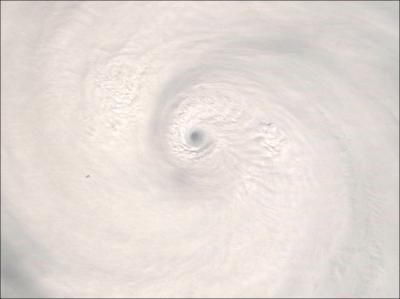
The Eye Of Hurricane Wilma In The Gulf Of Mexico – source: NASA MODIS
Click for big version
Supercomputer Weather: Super Hurricane Wilma
Compiled by Alastair Thompson
Useful
Links:
National Hurricane Warning Center
Weather Underground – Tropical
Google News – "Hurricane
Wilma"
Hurricane Wilma, which earlier today became the most intense hurricane ever recorded in the Atlantic, remains on track to make landfall on the Florida Peninsula sometime this weekend.
Wilma has broken a series of records since forming in the Caribbean south of Jamaica three days ago.
As soon as she became a named storm, Wilma became the 21st named storm for the 2005 season, equaling the previous record for the most named storms in a single season. And when she achieved Hurricane status a few short hours late she became the 12th hurricane of 2005, also equaling the previous record for a single season.
As the 2005 hurricane season still has more than a month to run 2005 will almost certainly break both of these records in the next few weeks.
However it was Wilma's plunging central barometric pressure over the past couple of days that has been the most remarkable feature in her so far short life.
Jeff Masters recorded in his blog at 4am NZT today:
There has never been a hurricane like Wilma before. With an unbelievable round of intensification that saw the pressure drop 87 mb in just 12 hours, Wilma smashed the all-time record for lowest pressure in an Atlantic hurricane this morning. The 4 am hurricane hunter report put the pressure at 882 mb, easily besting the previous record of 888 mb set in Hurricane Gilbert of 1988.
While Wilma has since weakened a little, with her pressure rising back to 892mb in the latest measurement, she remains an extraordinarily powerful storm. Also remarkable about Wilma, as can be seen in the eye image above, is her extremely small eye. Where many Hurricanes have eyes which are 30 nautical miles wide, Wilma's eye when she was at her most intense was just 2 nautical miles across.
The eye diameter of Wilma during this round of intensification shrunk as low as 2 nautical miles, which may be the smallest eye diameter ever measured in a tropical cyclone. The only eye I could find close to that small in the records was a 3 nm one, the Category 4 Typhoon Jeliwat in 2000. It's amazing the hurricane hunters were even able to penetrate the eye--it's really tough to hit a 2 mile wide eye when you're flying crabbed over at a 30 degree yaw angle fighting horizontal flight level winds of 185 mph and severe turbulence. This is an incredibly compact, amazingly intense hurricane, the likes of which has never been seen in the Atlantic. The Hurricane Season of 2005 keeps topping itself with new firsts, and now boasts three of the five most intense hurricanes of all time--Katrina, Rita, and Wilma.
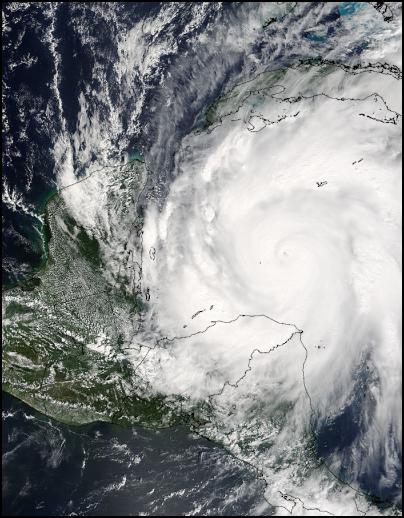
Click for big versionHurricane Wilma In The Gulf Of Mexico – source: NASA MODIS
Wilma has already killed at least 10 people in the island nation of Haiti in flash floods and her next target is Mexico's Yucatan Peninsula. It is unsure whether the eye of Wilma will make landfall there or not at this stage with most computer models bringing it extremely close to the coastline if not across it.
From there Wilma is expected to turn north east and make a run for the Florida coast. Thereafter its path is also a matter of considerable contention.
In the GFS Supercomputer forecast that follows Wilma makes a direct hit over the heavily populated tip of the Florida peninsula before turning further north, passing clear of the Carolina banks, and then eventually making landfall in New England close to the Canadian border, still as a hurricane.
In the official NHWC forecast of today, which also follows, Wilma crosses Florida to the north of Miami and then follows a similar path up the East Coast.
There is considerable disagreement between the computer models however and some models are indicating a Carolina landfall. Over the next few days some clarity may emerge on this issue.
The latest forecast from the National Hurricane Warning Center follows. The NHWC forecast is updated every few hours at http://www.nhc.noaa.gov/, and as Hurricane's are notoriously unpredictable it will pay to have a look fairly frequently if you live anywhere from Alabama to Miami, Cuba
NATIONAL HURRICANE CENTER FORECAST
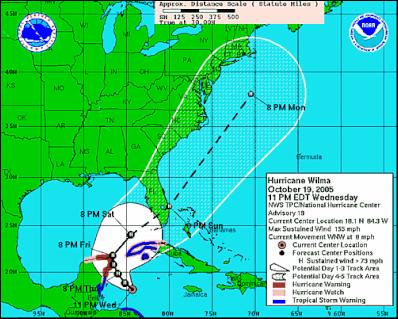
Tracking Map For Hurricane Wilma – National Hurricane Center
Click for big version
Click For Latest Tracking Map from the National Hurricane Center
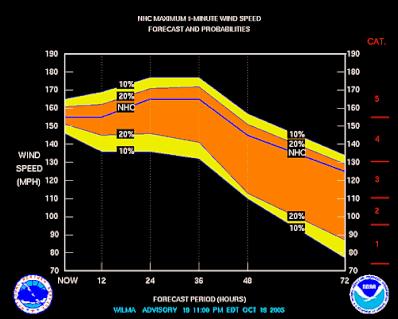
Intensity Forecast
For Hurricane Rita – National Hurricane
Center
Click for big version
Click For Latest Intensity Forecast from the
National Hurricane Center
Click For Latest Hurricane Discussion – National Hurricane Center
000
WTNT44 KNHC 200307
TCDAT4
HURRICANE WILMA DISCUSSION NUMBER 19
NWS TPC/NATIONAL HURRICANE CENTER MIAMI FL
11 PM EDT WED OCT 19 2005EARLIER REPORTS FROM AN AIR FORCE RESERVE HURRICANE HUNTER AIRCRAFT INDICATE THAT WILMA HAD A CENTRAL PRESSURE OF 892 MB INSIDE THE 4 N MI WIDE EYE...ALONG WITH 700 MB FLIGHT-LEVEL WINDS OF 140-150 KT. SINCE THAT TIME...SATELLITE IMAGERY SHOWS THAT THE EYE HAS BECOME CLOUD-FILLED. ADDITIONALLY...A 00Z SSM/I OVERPASS SHOWS THAT THE INNER EYEWALL HAS WEAKENED AS A 40 N MI WIDE OUTER EYEWALL BECOMES BETTER DEFINED. BASED ON THIS...THE INITIAL INTENSITY IS DECREASED TO 135 KT. THE NEXT AIRCRAFT IS SCHEDULED TO INVESTIGATE WILMA AROUND 05Z-06Z.
THE INITIAL MOTION IS A VERY WOBBLY 300/7. IN THE SHORT TERM...A LOW/MID-LEVEL RIDGE NORTH OF WILMA SHOULD STEER THE HURRICANE ON A GENERALLY NORTHWESTWARD TRACK TOWARD THE YUCATAN PENINSULA. AFTER 24-36 HR...THE RIDGE SHOULD WEAKEN AS A SHORTWAVE TROUGH MOVES THROUGH THE EASTERN UNITED STATES...FOLLOWED BY THE DEVELOPMENT OF A POWERFUL DEEP-LAYER TROUGH OVER THE EASTERN U. S.. THE FIRST SHORTWAVE SHOULD ALLOW WILMA TO TURN NORTHWARD...WHILE THE STRONGER TROUGH SHOULD EVENTUALLY RECURVE THE STORM INTO THE WESTERLIES. THE LATEST RUNS OF THE GFDL AND GFS HAVE RETURNED TO THEIR EARLIER NO-STALL RECURVATURE SCENARIO...THUS INCREASING THE AGREEMENT BETWEEN THE MODELS THROUGH 72-96 HR. HOWEVER...THE ENTIRE SUITE OF GUIDANCE IS SLOWER FOR THE FIRST 96 HR THAN THE EARLIER RUNS. THE NEW FORECAST TRACK IS SHIFTED A LITTLE TO THE LEFT FOR THE FIRST 48 HR...THEN IS SLOWER THAN THE PREVIOUS FORECAST FROM 48-96 HR. HOWEVER...EVEN THIS SLOWER FORECAST IS FASTER THAN THE GUIDANCE. IT SHOULD ALSO BE NOTED THAT THE TRACK IS ALONG THE RIGHT SIDE OF THE GUIDANCE ENVELOPE...A LITTLE TO THE RIGHT OF THE MODEL CONSENSUS.
WILMA SHOULD UNDERGO AN EYEWALL REPLACEMENT CYCLE DURING THE NEXT 12-24 HR. THE FIRST 36 HR OF THE INTENSITY FORECAST IS BASED ON THE PREMISE THAT WILMA WILL RE-INTENSIFY WHEN THE CYCLE IS OVER. THERE IS A CHANCE WILMA COULD WEAKEN MORE THAN CURRENTLY FORECAST BEFORE THE EYEWALL CYCLE ENDS. THE SHIPS MODEL IS FORECASTING A SIGNIFICANT INCREASE IN VERTICAL SHEAR ONCE WILMA REACHES THE THE GULF OF MEXICO. THAT COMBINED WITH COOLER SEA SURFACE TEMPERATURES SHOULD CAUSE A GRADUAL WEAKENING. THAT BEING SAID...WILMA IS STILL EXPECTED TO REACH FLORIDA AS A MAJOR HURRICANE. AFTER PASSAGE OVER FLORIDA...WILMA SHOULD CONTINUE TO WEAKEN DUE TO SHEAR AND EVEN COOLER WATER. THERE ARE TWO POSSIBILITIES THAT COULD MAKE LARGE DIFFERENCES IN THE INTENSITY OF WILMA. THE FIRST IS THE POSSIBILITY OF LANDFALL OVER YUCATAN OR THE INTERACTION WITH THE PENINSULA IN THE FORECAST CLOSE APPROACH. A LANDFALL WOULD RESULT IN A WEAKER STORM...WHILE INTERACTION COULD WEAKEN THE SYSTEM MORE THAN CURRENTLY FORECAST. THE SECOND IS POSSIBLE EXTRATROPICAL TRANSITION AND PHASING WITH THE DEEP TROUGH AFTER 96 HR. SHOULD THIS HAPPEN...WILMA COULD BECOME A POWERFUL STORM EITHER OVER THE WESTERN ATLANTIC OR THE NORTHEASTERN U. S..
FORECASTER BEVEN
FORECAST POSITIONS AND MAX WINDSINITIAL 20/0300Z 18.1N 84.3W 135 KT
12HR VT 20/1200Z 18.8N 85.2W 135 KT
24HR VT 21/0000Z 19.8N 86.0W 145 KT
36HR VT 21/1200Z 20.8N 86.5W 145 KT
48HR VT 22/0000Z 21.8N 86.6W 125 KT
72HR VT 23/0000Z 24.0N 84.5W 110 KT
96HR VT 24/0000Z 27.0N 80.0W 80 KT
120HR VT 25/0000Z 38.0N 70.5W 65 KT
$$
LATEST GFS SUPERCOMPUTER FLORIDA LANDFALL & AFTERMATH FORECAST FOR HURRICANE WILMA
+96 Hrs…
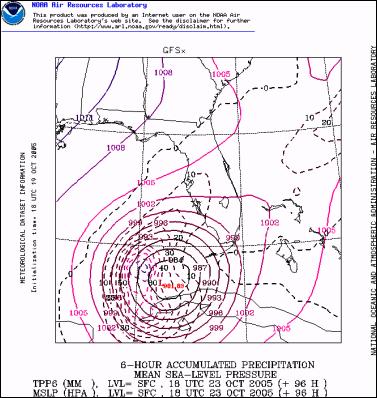
+102 Hrs…
+108 Hrs…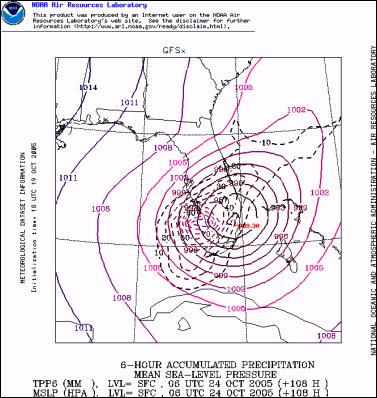
+114 Hrs…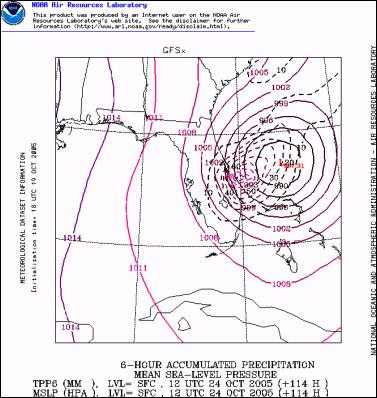
+120 Hrs…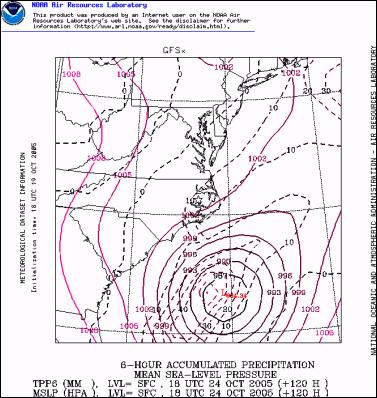
+126 Hrs…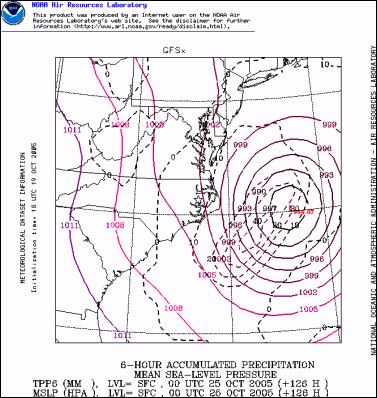
+132 Hrs…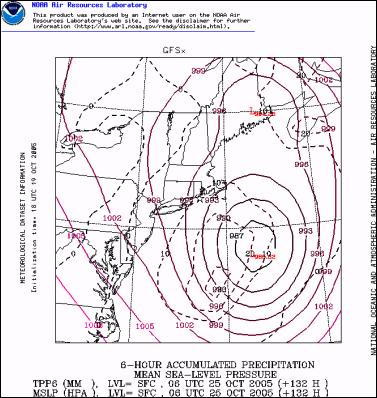
+138 Hrs…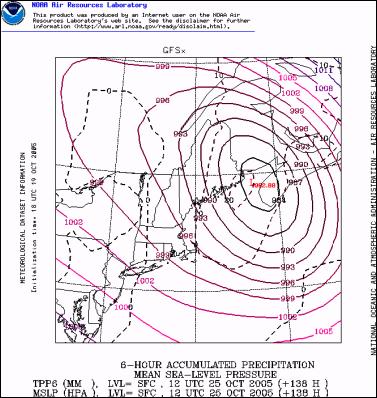
+144 Hrs…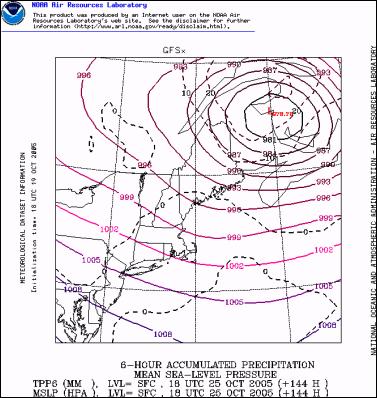



 Eugene Doyle: BBC Goes Full Goebbels In Support Of Israeli Soccer Hooligans
Eugene Doyle: BBC Goes Full Goebbels In Support Of Israeli Soccer Hooligans Binoy Kampmark: They Were There First - Election Denialism, The Democratic Way
Binoy Kampmark: They Were There First - Election Denialism, The Democratic Way Martin LeFevre - Meditations: Self-knowing Is The Gateway To Liberation And Transmutation
Martin LeFevre - Meditations: Self-knowing Is The Gateway To Liberation And Transmutation Alastair Thompson: Google's Support For Democracy And Media In NZ | Part 1 - The Digital Media Bargaining Bill, NZME, STUFF & Google
Alastair Thompson: Google's Support For Democracy And Media In NZ | Part 1 - The Digital Media Bargaining Bill, NZME, STUFF & Google Binoy Kampmark: The Remembrance Day Amnesia Racket
Binoy Kampmark: The Remembrance Day Amnesia Racket Gordon Campbell: On The Crown’s Sorry Excuse For An Apology
Gordon Campbell: On The Crown’s Sorry Excuse For An Apology